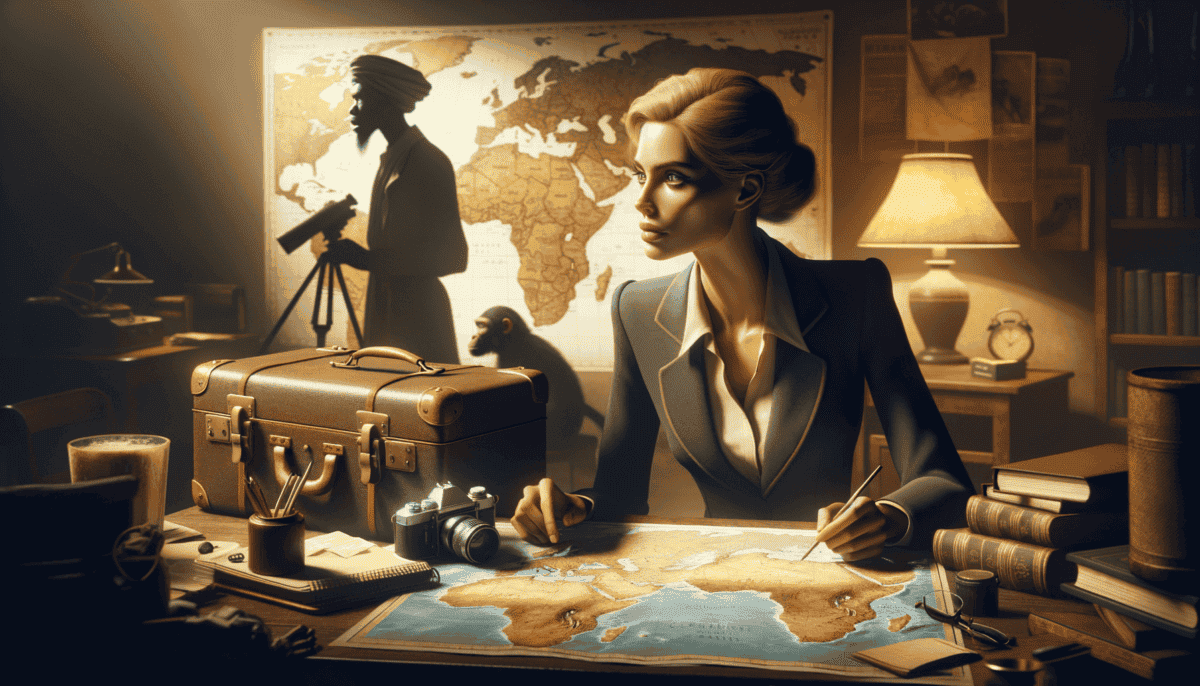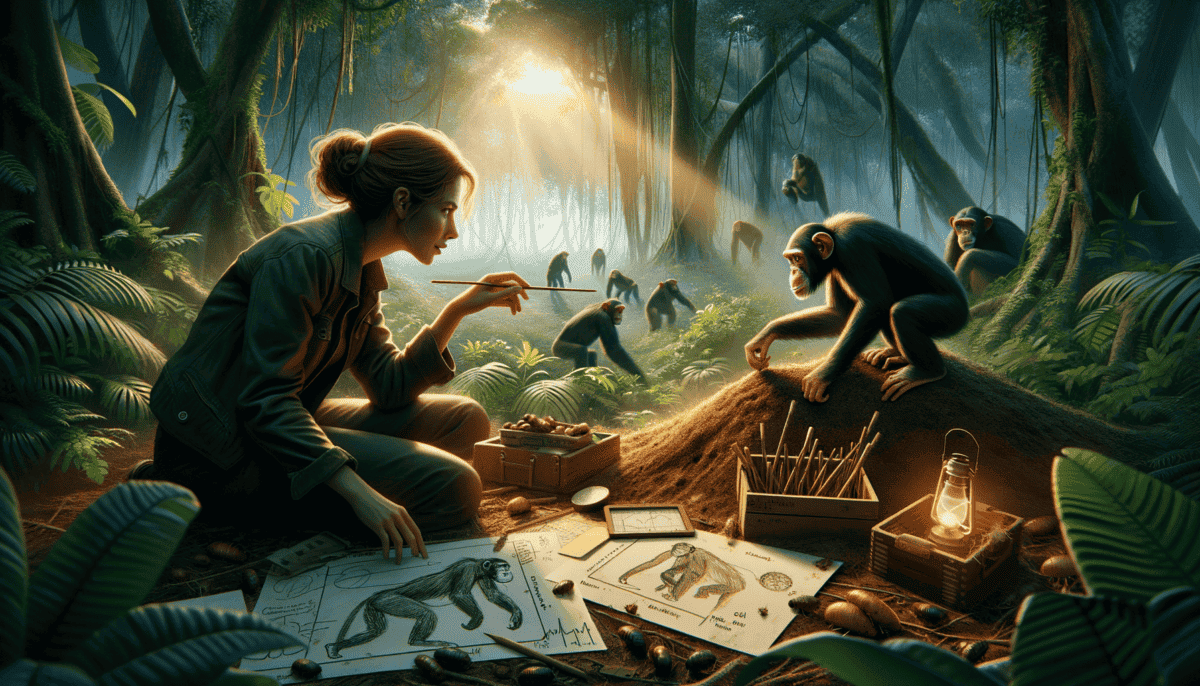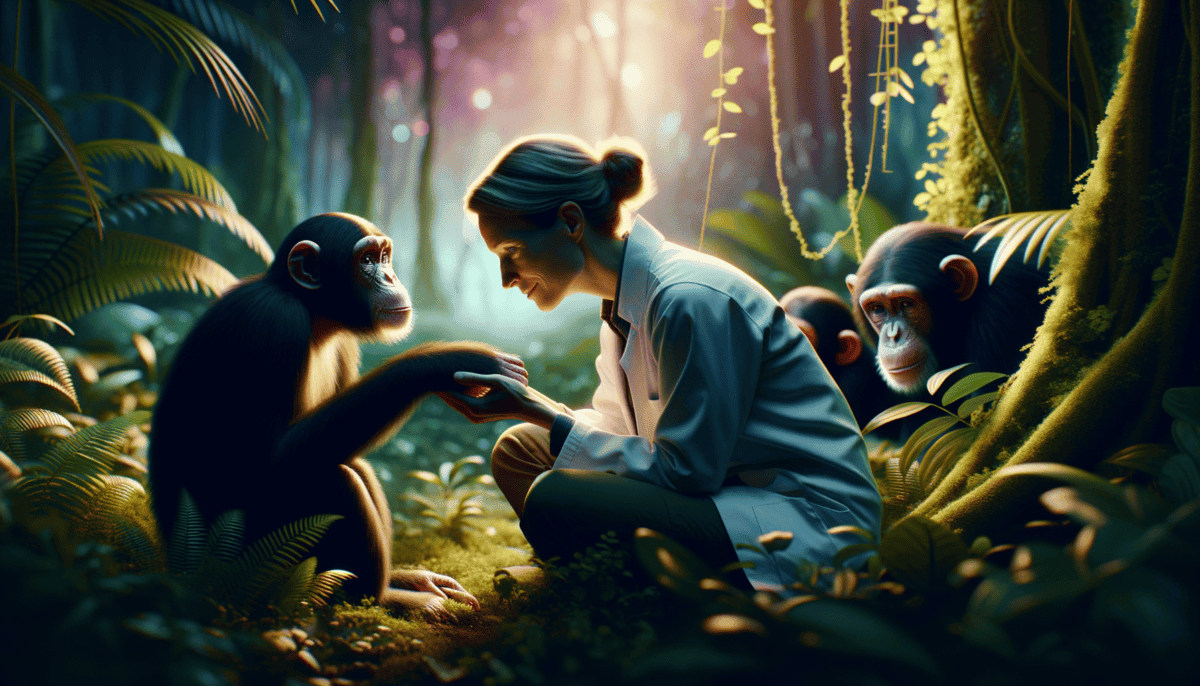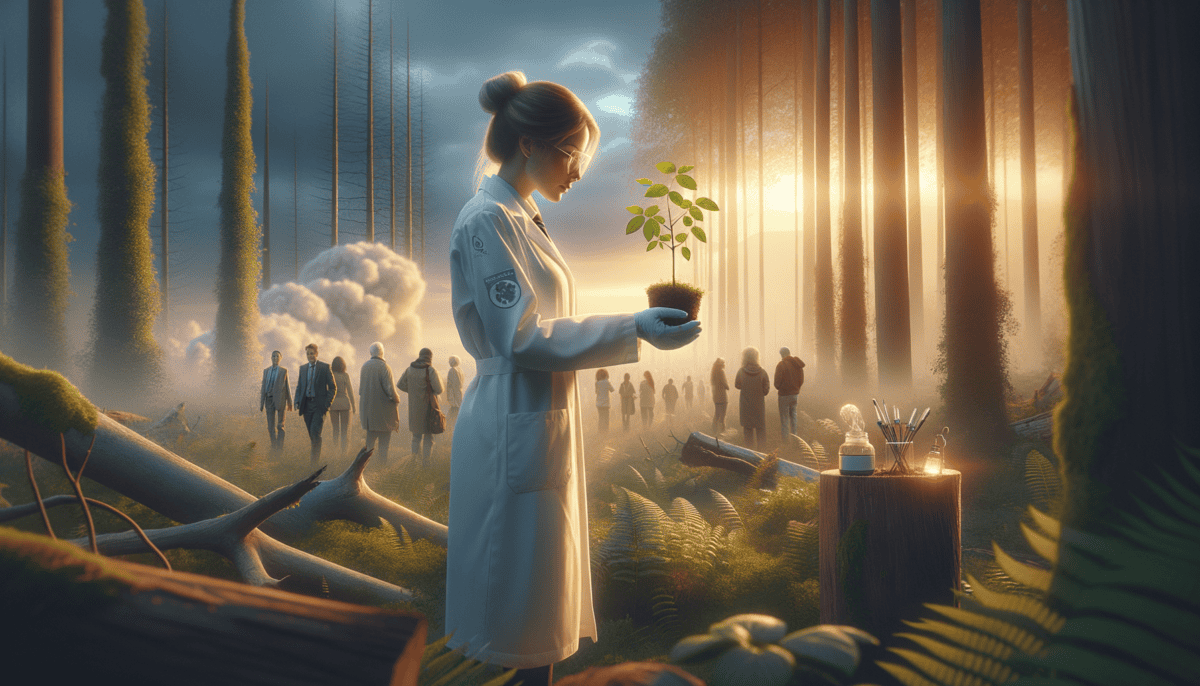The Curious Child
Little Jane sat by her bedroom window, clutching her favorite stuffed monkey named Jubilee. The stars twinkled outside as she dreamed of far-away places filled with wild animals.
"Mommy, will I ever see real monkeys?" Jane asked, her eyes bright with wonder.
Her mother smiled warmly. "If you work hard and follow your dreams, darling, anything is possible."
It was 1938 in London, England. Four-year-old Jane already knew she was different from other little girls. While they played with dolls, she spent hours watching the birds and insects in her garden.
One day, Jane made an exciting discovery. She wanted to know where eggs came from. So she hid in her family's chicken coop for hours! Her mother couldn't find her anywhere.
"Jane! Where are you?" her mother called, worried.
Finally, Jane burst into the house, her face glowing with excitement. "Mommy! I know how chickens lay eggs now! I saw it happen!"
Instead of scolding Jane for disappearing, her mother listened carefully to her daughter's discovery. She knew Jane's curiosity was special.
“If you’re interested in something, go and find out about it. Don’t give up until you have the answers you’re looking for.” – Jane’s mother’s advice
As Jane grew older, she read every book about animals she could find. Her favorite was Doctor Dolittle, who could talk to animals. But the story that changed her life was about a boy named Tarzan who lived in Africa with wild animals.
"I want to go to Africa!" Jane declared. "I want to live with animals and write about them, just like Tarzan!"
Many people laughed at her dream. In the 1940s, girls weren't supposed to have adventures in faraway places. But Jane didn't listen to them. She kept learning and dreaming.
To learn more about animals, Jane got a job as a waitress. She saved every penny she could. At night, she studied animal books and drew pictures of the creatures she hoped to meet one day.
Her room became a mini zoo of pictures, books, and notes about animals. Jane's mother encouraged her unusual interests, saying:
"Jane, if you really want something, and if you work hard, take advantage of opportunities, and never give up, you will find a way."
Those words stayed with Jane forever. She didn't know it yet, but her childhood dreams would take her on an amazing journey. Soon, she would discover things about animals that would change how people think about them forever.
Young Jane stood at her window one last time, holding Jubilee close. Africa was waiting, and she was ready for adventure.
The stars seemed to twinkle a little brighter that night, as if they knew what amazing things lay ahead for the curious little girl who loved animals…
Journey to Gombe
The warm African sun beat down as Jane stepped off the boat onto Tanzania’s shore. At 26 years old, her childhood dream was finally coming true!
“Welcome to Africa,” said Dr. Louis Leakey, the famous scientist who had hired Jane. “Are you ready to meet the chimps?”
The path to Gombe was not easy. Jane had to bring her mother along because in 1960, young women weren’t allowed to go into the forest alone. They lived in an old army tent near the beach.
“Look, Mom!” Jane pointed excitedly. “I can see the chimps up in those trees!”
But the chimps were scared. Every time Jane got close, they ran away. Days turned into weeks. Still, no chimps would let her near.
“Each day, I climbed higher into the mountains. Each day, the chimps ran away. But I never gave up.” – Jane’s daily thoughts
Jane had a special way of watching the chimps. She wore green clothes to blend in with the trees. She moved slowly and quietly. She never tried to chase them.
One special day, a chimp she named David Greybeard stayed near her instead of running away. He was munching on some yummy palm nuts.
“Mom! Mom!” Jane rushed back to camp that evening. “The chimps make tools! No one knew they could do that!”
Life in the forest was hard. Jane got fevers from malaria. Sometimes it rained for days. Food was simple – mostly beans and bananas. But Jane didn’t mind.
She gave all the chimps names instead of numbers:
- Fifi – a caring mother chimp
- Flint – a playful baby
- Goliath – a strong leader
- David Greybeard – the friendly one
Every day, Jane wrote in her notebook about what the chimps did. She drew pictures of their faces. She learned their special calls.
“Woo-hoo-hoo!” Jane practiced the chimps’ greeting sound. Sometimes, they even called back!
Slowly, the chimps began to trust Jane. They let her sit nearby while they played, ate, and took care of their babies. She was learning their secrets, one day at a time.
Other scientists were amazed by Jane’s discoveries. The chimps weren’t just animals – they had feelings, families, and could even make tools! This changed what everyone thought about animals.
As the sun set over Gombe each evening, Jane smiled. She was living her childhood dream. But this was just the beginning of her amazing adventure with the chimps…
Breaking New Ground
Jane sat quietly in her special spot, watching David Greybeard fish for termites. The morning sun sparkled through the trees.
“Look at that!” she whispered excitedly into her notebook. David was doing something amazing – he was changing his grass stem to make it work better!
“Mom!” Jane called out later at camp. “The chimps are even smarter than we thought!”
Her mother smiled. “Tell me everything you saw today, dear.”
Jane’s discoveries were shocking other scientists. Many didn’t believe her at first.
“Young lady, animals don’t make tools,” one scientist wrote to her. “You must be mistaken.”
But Jane knew what she saw. She kept watching and learning new things about her chimp friends:
- They had special calls for different foods
- They hugged and kissed to show love
- They could be happy, sad, or angry
- They went hunting in groups
One day, Jane saw something that made her very sad. Two groups of chimps were fighting over food.
“Why are you naming the chimps?” asked another scientist who visited. “That’s not how we do research.”
Jane stood tall. “Each chimp is special. They’re not just numbers – they have personalities!”
She watched baby Flint playing with his mom, Flo. He was learning how to crack nuts with rocks. When he got frustrated, Flo showed him how to do it better.
“They teach their babies,” Jane wrote in her notebook. “Just like human moms teach their children!”
Being a female scientist wasn’t easy. Some people didn’t take her seriously because she was a woman. But Jane kept working hard.
“Look at the evidence,” Dr. Leakey told other scientists. “Jane’s findings are changing what we know about chimps!”
More scientists started coming to watch Jane work. They were amazed by how close she could get to the chimps.
“The secret is patience,” Jane explained. “And truly caring about them.”
One rainy morning, something magical happened. David Greybeard walked right up to Jane’s tent. He took a banana from her hand. It was a moment she’d never forget.
Now everyone could see that Jane’s gentle way of studying chimps worked better than watching from far away. She was showing the world a new way to learn about animals.
Back in her tent that night, Jane looked at her notebooks full of discoveries. The chimps had so many more secrets to share. And she was ready to learn them all…
Hearts and Minds
The morning mist floated through Gombe as Jane watched a special moment. Baby Flint was snuggling with his mother Flo.
“Look at how gentle she is,” Jane whispered into her recorder. Flo was picking tiny bugs out of Flint’s fur, making soft happy sounds.
When Flint got scared by a loud bird, Flo gave him a big hug. This made Jane smile. She wrote in her notebook:
“Chimps comfort each other when they’re scared – just like we do!”
Later that day, Jane saw something that made her heart hurt. Old Goliath was sitting alone, looking very sad. His best friend had died the week before.
“They feel grief,” Jane told her mom that evening. “They miss their friends when they’re gone.”
One morning, something amazing happened. Two young chimps were playing chase through the trees. When one fell and got hurt, the other one stopped to help!
Jane watched as they shared some fruit afterward:
“Did you see that?” she asked her assistant. “They care about each other!”
“Just like friends at school,” her assistant agreed.
Jane noticed lots of ways chimps showed their feelings:
- Dancing when they’re happy
- Hugging when scared
- Stomping when angry
- Sharing food with friends
- Taking care of sick family members
Some chimps even had best friends! Jane watched as David Greybeard and Goliath spent almost every day together. They shared food and helped each other find the tastiest fruits.
One stormy afternoon, Jane saw something that proved how smart chimps are about feelings. Little Flint was trying to climb a tall tree, but he was scared.
His big sister Fifi came over. She showed him an easier way up, then waited patiently while he followed. When Flint made it, they hugged!
“They understand when others need help,” Jane wrote. “They want to make each other feel better.”
That night in her tent, Jane thought about everything she’d seen. Chimps weren’t just smart about tools – they were smart about feelings too!
“Maybe,” she said to herself, “if people understood how much chimps care about each other, they’d want to protect them more.”
The next morning, Jane watched a mother chimp teaching her baby how to catch tasty ants. The baby kept trying until he got it right. His mom celebrated by giving him a big hug.
Jane smiled. There was still so much more to learn about these amazing animals. Every day brought new surprises about how they think and feel…
A Call to Action
Jane stood at the edge of the forest, her heart heavy. Where trees once grew tall and proud, now there were only stumps.
“We have to do something,” Jane told her team. She watched as David Greybeard’s family searched for food in the smaller forest.
That evening, Jane wrote in her journal:
“It’s not enough just to study the chimps anymore. We need to protect them!”
Jane started the Jane Goodall Institute to help save the chimps. Her plan had three big parts:
- Save the forests where chimps live
- Help local people take care of nature
- Teach kids about protecting animals
“What’s happening to our forest?” asked a local child named Moshi.
“People are cutting trees to make farms,” Jane explained. “But we can plant new trees together!”
Jane traveled around the world to tell people about the chimps. She spoke to big groups of people:
“These amazing animals need our help,” she would say. “They feel love and sadness just like we do!”
Many people were surprised to learn how special chimps are. They wanted to help save them!
Back in Gombe, Jane started a special program. She helped local families learn new ways to grow food without cutting down trees.
“Look!” said Moshi’s mother. “We can grow vegetables and save the forest too!”
Jane also made sure sick or hurt chimps got help. She built special places where people could take care of them.
One day, she saw something that made her very happy. Baby Flint was playing in a patch of new trees that her team had planted.
“Every small action helps,” she told her team. “Together, we can make big changes!”
Jane’s work was making a difference! More people started caring about saving chimps. Kids all over the world joined her team to help protect nature.
But there was still more work to do. Every morning, Jane would wake up thinking about new ways to help the chimps.
“The chimps taught me so much,” she said. “Now it’s my turn to help them.”
As the sun set over Gombe, Jane watched David Greybeard’s family playing in their forest home. She smiled, knowing that more and more people were joining her fight to protect these amazing animals…
Making the World Better
Today, Jane travels all around the world. She tells everyone about the chimps and how we can help them!
One special thing Jane created is called Roots & Shoots. It’s a club for kids who want to help animals and the Earth.
“What can we do to help?” asked Maria, a young girl at one of Jane’s talks.
“Every person can make a difference,” Jane smiled. “Even small actions count!”
“Remember, what you do today can change tomorrow!”
Thanks to Jane’s work, many good things have happened:
- More forests are safe for chimps
- People understand chimps better
- Kids everywhere help protect nature
- Scientists learn new things about animals
- More people care about saving Earth
Back in Gombe, the forest is growing again. Baby chimps play in trees that Jane’s team planted years ago.
“Look!” says a young researcher, pointing to a baby chimp using a stick to catch termites. “Just like you saw David Greybeard do many years ago!”
Jane smiles. She remembers that exciting day when she first saw chimps using tools. Now, new scientists continue her important work.
“The chimps taught me that animals are special,” Jane tells students. “They feel happy and sad, just like us!”
“Each day brings new hope. As long as we work together, we can make things better.”
Young scientists now follow in Jane’s footsteps. They study and protect animals all over the world.
Jane may have started her journey alone in Gombe, but now millions of people help protect chimps and nature. Her dream of helping animals grew into something much bigger!
“What’s next?” people often ask Jane.
“There’s always more to learn and do,” she answers with a bright smile. “Nature needs all of us to be its helpers!”
And so, Jane’s story continues through all the people she has inspired. Every day, more kids and grown-ups join her mission to protect our Earth and all its amazing animals.
The little girl who once dreamed of going to Africa became someone who taught us all how to be better friends to animals and the Earth. And that’s just the beginning of the story…






